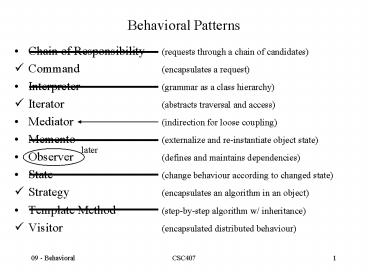Behavioral Patterns - PowerPoint PPT Presentation
Title:
Behavioral Patterns
Description:
Mediator (indirection for loose coupling) Memento (externalize and re-instantiate object state) ... State (change behaviour according to changed state) ... – PowerPoint PPT presentation
Number of Views:14
Avg rating:3.0/5.0
Title: Behavioral Patterns
1
Behavioral Patterns
- Chain of Responsibility (requests through a chain
of candidates) - Command (encapsulates a request)
- Interpreter (grammar as a class hierarchy)
- Iterator (abstracts traversal and access)
- Mediator (indirection for loose coupling)
- Memento (externalize and re-instantiate object
state) - Observer (defines and maintains dependencies)
- State (change behaviour according to changed
state) - Strategy (encapsulates an algorithm in an
object) - Template Method (step-by-step algorithm w/
inheritance) - Visitor (encapsulated distributed behaviour)
2
Mediator
- Defines an object that encapsulates how a set of
objects interact. - promotes loose coupling by keeping objects from
referring to each other explicitly - lets you vary their interaction independently
3
Motivation
- A collection of widgets that interact with one
another. - e.g., certain familes may not have certain
weights - disable demibold choice
4
Motivation
- Create a mediator to control and coordinate the
interactions of a group of objects.
5
Motivation
- e.g.,
- list box selection moving to entry field
- entryField now calls WidgetChanged() and
enables/disables - entry field does not need to know about list box
and vice-versa
6
Motivation
7
Applicability
- A set of objects communicate in a well-defined
but complex manner - reusing an object is difficult because it refers
to and communicates with many other objects - a behavior that's distributed between several
classes should be customizable without a lot of
subclassing
8
Structure
9
Structure
- Mediator
- defines an interface for communicating with
Colleague objects - ConcreteMediator
- knows and maintains its colleagues
- implements cooperative behavior by coordinating
Colleagues - Colleague classes
- each Colleague class knows its Mediator object
- each colleague communicates with its mediator
whenever it would have otherwise communicated
with another colleague
10
Consequences
- limits subclassing
- localizes behaviour that otherwise would need to
be modified by subclassing the colleagues - decouples colleagues
- can vary and reuse colleague and mediator classes
independently - simplifies object protocols
- replaces many-to-many interactions with
one-to-many - one-to-many are easier to deal with
- abstracts how objects cooperate
- can focus on object interaction apart from an
objects individual behaviour - centralizes control
- mediator can become a monster































